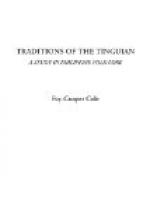On page 105 we are told that Kanag’s half sister is a medium, and the description of her method of summoning the spirits tallies with that of to-day. At the Sayang ceremony she is called to perform the Dawak [23], with the assistance of the old woman Alokotan (p. 106). The Dawak is also held in order to stop the flow of blood from Aponitolau’s finger (p. 113). The only other ceremony mentioned is that made in order to find a lost switch (p. 91).
Certain well-known customs are strongly brought out in our material. The first, and apparently most important, is the necessity of offering liquor and food, both to strangers and to guests (p. 58). Refusal is so keenly resented that in one instance a couple decline to allow their daughter to marry a man whose emissaries reject this gift (p. 73). Old quarrels are closed by the tender of food or drink, and friendships are cemented by the drinking of basi [24] (p. 134). People meeting for the first time, and even friends who have been separated for a while, chew betel-nut together and tell their names and places of residence. We are repeatedly told that it is necessary to chew the nut and make known their names, for “we cannot tell our names unless we chew,” and “it is bad for us if we do not know each other’s names when we talk.” A certain etiquette is followed at this time: old men precede the younger; people of the home town, the visitors; and men always are before the women (pp. 45, 133). The conduct of Awig when he serves liquor to the alzados [25] is that of to-day, i.e., the person who serves always drinks before passing it to others (p. 156).
Certain other rules of etiquette or restrictions on conduct come out in the tales. We learn that it is not considered proper for a man to eat with the wife of another during his absence, nor should they start the meal before he comes in (p. 52). The master of a dance is deeply chagrined and chides his wife severely, because she insists on dancing before he has invited all the others to take their turns (p. 70). Greediness is reproved in children and Aponitolau causes the death of his concubines whose false tales had led him to maltreat his wife (p. 116). Unfaithfulness seems to be sufficient justification for a man to abandon his wife and kill her admirer (p. 78); but Kanag appears as a hero when he refuses to attack his father who has sought his life (p. 121).
Of the ceremonies connected with death we learn very little except that the women discard their arm beads, the mourners don old clothing, and all wail for the dead (pp. 44, 90). Three times we are told that the deceased is placed on a tabalang, or raft, on which a live rooster is fastened before it is set adrift on the river. In the tales the raft and fowl are of gold, but this is surprising even to the old woman Alokotan, past whose home in Nagbotobotan all these rafts must go (p. 131).




